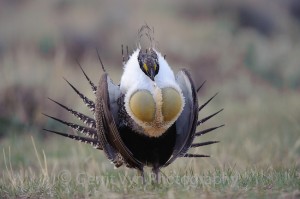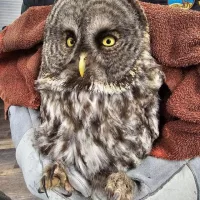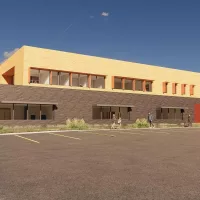Washington, DC – Secretary of the Interior Sally Jewell today issued a Secretarial Order calling for a comprehensive science-based strategy to address the more frequent and intense wildfires that are damaging vital sagebrush landscapes and productive rangelands, particularly in the Great Basin region of Idaho, Utah, Nevada, Oregon and California.

The strategy will begin to be implemented during the 2015 fire season. Goals include reducing the size, severity and cost of rangeland fires, addressing the spread of cheatgrass and other invasive species, and positioning wildland fire management resources for more effective rangeland fire response.
“Targeted action is urgently needed to conserve habitat for the greater sage-grouse and other wildlife in the Great Basin, as well as to maintain ranching and recreation economies that depend on sagebrush landscapes,” said Secretary Jewell. “The Secretarial Order further demonstrates our strong commitment to work with our federal, state, tribal and community partners to reduce the likelihood and severity of rangeland fire, stem the spread of invasive species, and restore the health and resilience of sagebrush ecosystems.”
The Secretarial Order establishes a top-level Rangeland Fire Task Force, chaired by Interior’s Deputy Secretary Mike Connor, includes five assistant secretaries, and lays out the goals and timelines for completing the Task Force’s work.
The Task Force will work with other federal agencies, states, tribes, local entities and non-governmental groups on fire management and habitat restoration activities. This includes enhancing the capability and capacity of our partners’ fire management organizations through improved and expanded education and training. The Task Force also will encourage improved coordination among all partners involved in rangeland fire management to further improve safety and effectiveness.
The Order builds on wildland fire prevention, suppression and restoration efforts to date, including the National Cohesive Wildland Fire Management Strategy, which provides a roadmap for achieving “all hands—all lands” cooperation, and the President’s wildland fire budget proposal to change how fire suppression costs are budgeted to treat extreme fire seasons the way other emergency disasters are treated. The budget proposal would provide greater certainty in addressing growing fire suppression needs while better safeguarding prevention and other non-suppression programs, such as fuels reduction and post-fire rehabilitation.
The accelerated invasion of non-native grasses and the spread of pinyon-juniper, along with drought and the effects of climate change, increased the threat of rangeland fires to the sagebrush landscape and the more than 350 species of plants and animals, such as mule deer and pronghorn, that rely on this critically important ecosystem. The increasing frequency and intensity of rangeland fire in sagebrush ecosystems has significantly damaged the landscape on which ranchers, livestock managers, hunters and outdoor recreation enthusiasts rely. This unnatural fire cycle puts at risk their economic contributions across this landscape that support and maintain the Western way of life in America.
Efforts to conserve and protect sagebrush habitat are the centerpiece of an historic campaign to address threats to greater sage-grouse prior to the U.S. Fish and Wildlife Service’s court-ordered 2015 deadline whether to propose the bird for Endangered Species Act protection.
Secretary Jewell is working with Western governors to improve wildland fire-fighting capacity at all levels, highlighting the proactive voluntary partnership with ranchers, farmers and other landowners to conserve the sagebrush landscape on private and public lands. Interior’s November 5-7, 2014, conference in Idaho, The Next Steppe: Sage-grouse and Rangeland Fire in the Great Basin, brought together fire experts and land managers at the federal, state and local levels who underscored the need for a comprehensive, landscape-scale strategy to rangeland fire suppression and prevention.
At the December 6, 2014, Western Governors’ Association winter meeting, Jewell directed her Department’s leadership to develop a comprehensive strategy to fight rangeland fire with an eye toward protecting rural communities, sagebrush landscapes and habitats essential to the conservation of the sage-grouse and other wildlife.
“These efforts will help Governors, state, tribal and local fire authorities, and those landowners on the ground – including rangeland fire protection associations and rural volunteer fire departments – make sure they have the information, training and tools to more effectively fight the threat of rangeland fires,” said Jewell. “To protect these landscapes for economic activity and wildlife like the greater sage-grouse, we need a three-pronged approach that includes strong federal land management plans, strong state plans, and an effective plan to address the threat of rangeland fire.”
Because about 64 percent of the greater sage-grouse’s 165 million acres of occupied range is on federally managed lands, Interior’s Bureau of Land Management and the Department of Agriculture’s U.S. Forest Service are currently analyzing amendments to existing land use plans to incorporate appropriate conservation measures to conserve, enhance and restore greater sage-grouse habitat by reducing, eliminating or minimizing threats to the habitat.
State and private lands, which make up a significant portion of the priority and general habitat for the greater sage-grouse, are also critical for the species. As a result, the Department is working in an unprecedented partnership with the states to provide strong habitat protection and conservation measures on the lands they administer. As part of her efforts with Western governors, Secretary Jewell encouraged, assisted and highlighted the proactive, voluntary state and federal partnership with ranchers, farmers and other landowners to conserve the sagebrush landscape on private and public lands.
The rangeland fire Secretarial Order will help frame the third part of the greater sage-grouse conservation strategy by encouraging further federal, state, tribal and local protection for those vulnerable sagebrush lands in the Great Basin states.
Greater sage-grouse once occupied more than 290 million acres of sagebrush in the West, but the bird, known for its flamboyant mating ritual at sites called leks, has lost more than half of its habitat since then. Settlers reported that millions of birds once took to the skies; current estimates place population numbers between 200,000 and 500,000 birds. The species now occurs in 11 states and two Canadian provinces. More information on the greater sage-grouse and the ongoing, collaborative work to conserve the sagebrush landscape is available at: http://www.fws.gov/greatersagegrouse/
If you see local news happen, call the Horizon Broadcasting Group News Tip Hotline at 541-323-NEWS, or email us.















